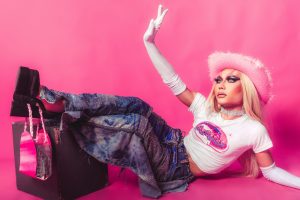A vivid fusion of culture and ink, pop art tattoos are creating a splash in the body art scene with their bold colors and striking patterns. Pop art as a movement emerged in the 1950s and 60s, challenging traditional notions of high art by embracing the aesthetics of popular culture, mass media, and consumerism.
This movement has significantly influenced the realm of tattoo art, adding a fresh, colorful twist to skin artistry. Today, the importance and growing popularity of pop art-inspired tattoos in contemporary culture remains undeniable.
They stand as intriguing embodiments of individuality, personal expression, and the relentless march of artistic evolution. Delve deeper into the world of pop art tattoos and unravel the illustrious history of the pop art movement and its inevitable intertwining with tattoo culture.
Evolution of Pop Art Tattoos
The evolution of pop art tattoos has been a journey of artistic rebellion, constantly pushing the boundaries of creativity and breaking free from traditional design norms. It’s a story of color, contrast, and cultural revolution, etched in ink and worn with pride.
Origin and Influence of Pop Art in Tattoo Culture
The roots of pop art lie in the mid-20th century, a time of rapid change and cultural upheaval. This form of art, which took inspiration from everyday objects and mass media, broke through the seemingly impenetrable wall between high art and popular culture.
Artists like Andy Warhol and Roy Lichtenstein were among the pioneers of this movement, taking everyday objects and images from consumer culture and transforming them into works of art. Warhol’s soup cans and Lichtenstein’s comic strip-inspired artworks were a direct affront to the traditional art establishment, and they changed the face of art forever.
The integration of pop art into tattoo design took the form of a parallel rebellion, breaking free from the shackles of traditional tattoo aesthetics. Pop art’s bold lines, vivid colors, and unabashed embrace of contemporary culture found a natural home in the tattoo industry. Many pop art tattoo artists drew inspiration from the works of Warhol, Lichtenstein, and other pop art icons, incorporating their unique styles into their designs. This has given rise to a new breed of tattoos: vibrant, expressive, and deeply rooted in the culture of the time.
The influence of pop art in tattoo culture has been pervasive and enduring. It has opened up new avenues for self-expression, empowering individuals to wear their passions, interests, and identities on their skin. Today, pop art tattoos are more than just a trend – they are a testament to the power of art to inspire, provoke, and transform.
Fusion of Pop Art and Tattooing Techniques
The fusion of pop art and tattooing techniques is a delightful blend that combines traditional tattoo methods with elements drawn from the iconic pop art movement. Mastering this artistic craft requires understanding both the fundamentals of pop art and tattooing techniques.
Pop art is characterized by its bold and vibrant color palette, often incorporating primary colors and sharp outlines for heightened contrast. The subject matter typically revolves around mundane, everyday objects or popular culture elements presented in an unconventional and exaggerated manner. It is this unique pop art tattoo style that has found its way into the tattooing world.
Tattoo artists, inspired by pop art, utilize a variety of techniques to translate these components onto the skin. Among these techniques, color packing is arguably the most vital. This practice involves saturating the skin with intense color, mirroring the vibrant hues that are a trademark of pop art.
Further, artists use bold, black outlining to encapsulate the color. This is a nod to the stark black lines seen in much of the pop art movement, particularly in the works of Roy Lichtenstein. The sharp contrast between the black outlines and the bright colors produces a striking effect that is instantly recognizable as a pop art tattoo.
Shading techniques also play a significant role in pop art tattoos. While traditional tattoos often use gradient shading to create a three-dimensional look, pop art tattoos often employ flat shading. This involves applying a uniform color across a particular area without any gradient. The result is a two-dimensional effect that harks back to the comic strip aesthetic of classic pop art.
To create the exaggerated, often surreal imagery typical of pop art, tattoo artists often employ distortion. This might involve bending or stretching proportions, emphasizing certain features, or injecting a sense of humor or satire into the design. These distortions help to encapsulate the spirit of the pop art movement, offering a fresh and exciting avenue for self-expression through body art.
By incorporating these traditional pop art elements and techniques into tattoo designs, artists are able to create vibrant, eye-catching pop art tattoos that truly resonate with the wearer and stand out in the crowd. It’s a bold, dynamic style that continues to push the boundaries of what is possible in the world of body art.
Popular Themes and Designs in Pop Art Tattoos
Pop Art tattoos incorporate a variety of themes and designs that pay homage to the movement’s rich legacy while introducing contemporary elements. They are characterized by their vibrant colors, bold outlines, and innovative use of everyday imagery. These tattoos often depict iconic personalities, popular culture symbols, and classic consumer products, all interpreted through the distinctive lens of Pop Art.
Iconic Pop Art References in Tattoos
Pop art tattoos often incorporate references to iconic works or artists from the pop art movement, translating these pieces into striking and vibrant body art.
- Roy Lichtenstein’s Comic Book Style: Lichtenstein’s work is characterized by its inspiration from comic strips, complete with speech bubbles, dynamic lines, and bold primary colors. Tattoos that reference Lichtenstein often mimic this comic book aesthetic, using clear black lines, bright colors, and even incorporating text in a comic-like font. These tattoos can range from direct recreations of Lichtenstein’s work to custom designs that borrow his distinctive style.
- Andy Warhol’s Portraits: Andy Warhol is perhaps best known for his silkscreen portraits of celebrities like Marilyn Monroe, each portrait replicated with slight variations in color. This has inspired a popular trend in pop art tattoos: recreating Warhol’s famous portraits or using his style to create new ones. These tattoos often feature flat, bold colors and simple, minimalistic designs, capturing Warhol’s unique blend of pop culture and art.
Colorful and Bold Designs in Pop Art Tattoos
The use of vibrant colors and bold outlines is a defining characteristic of pop art tattoos. These design elements capture the vivacity and cultural resonance of the pop art movement.
- Vibrant Colors: Pop art tattoos are known for their use of vibrant, often primary colors. These colors capture the eye and make the tattoo stand out. Some popular color schemes include strong reds, yellows, and blues, or alternatively, bright pastel hues for a softer but equally striking effect.
- Bold Outlines: Pop art tattoos often feature bold, black outlines that separate different colors and shapes within the design. These outlines are reminiscent of the comic book aesthetic popularized by artists like Roy Lichtenstein. This technique not only enhances the visual impact of the tattoo but also helps the colors to ‘pop,’ living up to the name ‘pop art.’
- Strong Contrast: Another common feature of pop art tattoos is the use of contrast. This is often achieved through the juxtaposition of bright colors against darker ones or by using black outlines to create a stark contrast against vibrant colors. This vivid contrast helps to create a bold, striking effect, emphasizing the artwork’s visual impact.
These design elements have cemented pop art tattoos as a truly captivating form of body art, offering a bold and colorful way for individuals to express their unique tastes and styles.
Pop Art Tattoos in Contemporary Fashion and Culture
In the constantly evolving world of fashion and culture, pop art tattoos have carved out a significant niche for themselves. The marriage of pop art aesthetics with the personal nature of tattoos has had a profound impact on contemporary culture and fashion.
This distinctive form of body art has transcended the confines of the tattoo parlor, influencing clothing designs, accessory styles, and overall fashion aesthetics. It has permeated various aspects of popular culture, featured prominently in music videos, films, and fashion editorials, and has become a powerful tool for self-expression among youth and adults alike.
Today, pop art tattoos are not just a form of individual expression, but they also act as a style statement, influencing fashion trends and shaping cultural discourse.
Celebrity Influence and Pop Art Ink
The impact of pop art tattoos on contemporary culture and fashion trends has been significantly amplified by the influence of celebrities and public figures. Many famous personalities have embraced pop art-inspired tattoos, contributing to their growing popularity and trendsetting appeal. These celebrities, hailing from diverse fields such as music, film, sports, and even fashion, have boldly showcased their pop art tattoos, leading to a surge in their recognition and acceptance.
A case in point is pop singer Miley Cyrus, who sports a tattoo inspired by Roy Lichtenstein’s pop art. The tattoo, located on her inner forearm, features a woman crying, a classic motif in Lichtenstein’s works. Justin Bieber, another pop sensation, also boasts a pop art-esque tattoo of a cartoonish eye, further contributing to the trend.
On the sports front, professional basketball player Kevin Durant sports a colorful tattoo inspired by the iconic cover art of the Beatles’ album, “Yellow Submarine,” a reference often associated with the pop art movement.
These celebrities not only wear their pop art tattoos with pride but are often seen flaunting them in public appearances, music videos, and social media posts. The visibility and acceptance of pop art tattoos among these trendsetters have had a profound influence on their fans and followers, inspiring many to explore the vibrant world of pop art tattoos. Thus, celebrities play a crucial role in the popularization and acceptance of pop art tattoos in contemporary fashion and culture.
Social Media and Pop Art Tattoo Trends
Social media has been instrumental in the promotion and popularization of pop art tattoos. Platforms such as Instagram, Pinterest, and TikTok are rich repositories of the best pop art tattoo designs, showcasing the creative talents of tattoo artists from around the globe. They provide a platform for artists to display their work, reach a wider audience, and engage in a dynamic exchange of ideas and inspiration.
These platforms are not only a showcase for individual designs but also serve as a barometer for emerging trends in the world of pop art tattoo inspirations. When a particular design or theme strikes a chord with the online community, it can quickly gain traction and go viral. The hashtag feature on these platforms facilitates this process, allowing users to discover new trends, follow their favorite artists, and find inspiration for their next tattoo.
Several pop art tattoo trends have taken social media by storm in recent years. Among them, comic strip-style tattoos, inspired by Roy Lichtenstein’s work, have become a significant trend. These tattoos, characterized by their bold lines, primary colors, and dramatic expressions, have found a substantial following on social media platforms. The hashtag #poparttattoo on Instagram boasts over 82,000 posts, demonstrating the style’s popularity.
Similarly, tattoos featuring iconic pop art figures, such as Andy Warhol’s Marilyn Monroe or Campbell’s soup can, have also gained viral attention. For instance, a quick search for #warholtattoo reveals a plethora of posts featuring Warhol-inspired tattoos, reflecting the enduring influence of his style.
Social media has also facilitated the rise of hybrid trends, where pop art is fused with other tattoo styles. For instance, the blackwork pop art trend merges the bold, black aesthetic of traditional blackwork tattoos with the vibrant colors and iconic imagery of pop art, creating a striking contrast.
There are also some trends incorporating pop art into tattoo sleeves. Some pop art tattoo sleeve ideas are inspired by comic strips, incorporating text and images from popular comics. Others use vibrant colors, bold lines, and iconic imagery to create a cohesive pop art-inspired sleeve that makes a powerful statement.
Social media has played a pivotal role in popularizing pop art tattoos, fostering a global community of enthusiasts, fostering creative expression, and driving new trends. The viral nature of these platforms ensures that pop art tattoos will continue to evolve, inspire, and captivate the digital generation.
Frequently Asked Questions (FAQs)
Are pop art tattoos suitable for any skin tone?
Yes, pop art tattoos are suitable for all skin tones. The vibrant colors can be adjusted according to individual skin tones for optimal visibility and contrast.
How much does a pop art-inspired tattoo typically cost?
The price can vary based on size, complexity, and colors used. On average, it may range from $150 to $500. Always consult with your tattoo artist for accurate pricing.
What are the aftercare tips for maintaining a pop art tattoo’s vibrancy?
Ensure to keep the tattoo clean and moisturized, avoid exposure to direct sunlight, and use sunscreen when outdoors to maintain the vibrancy of your tattoo.




